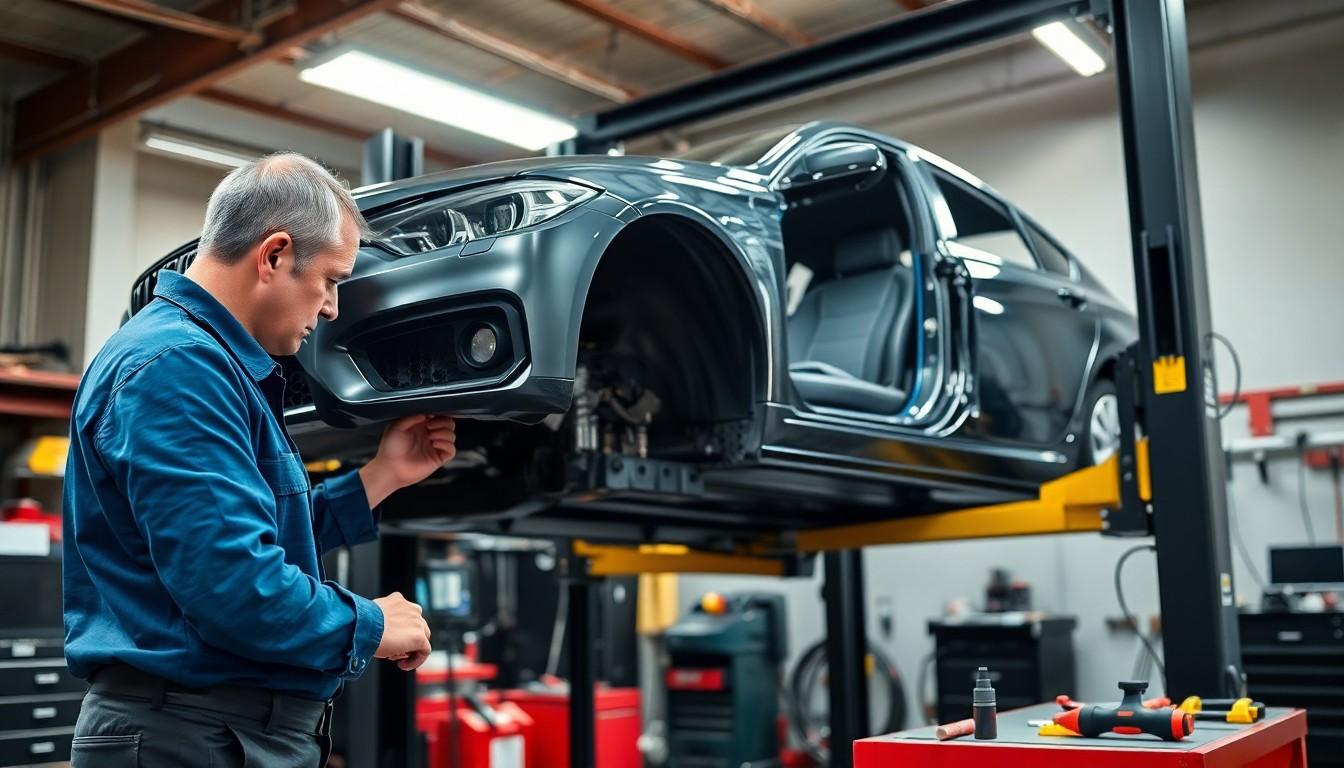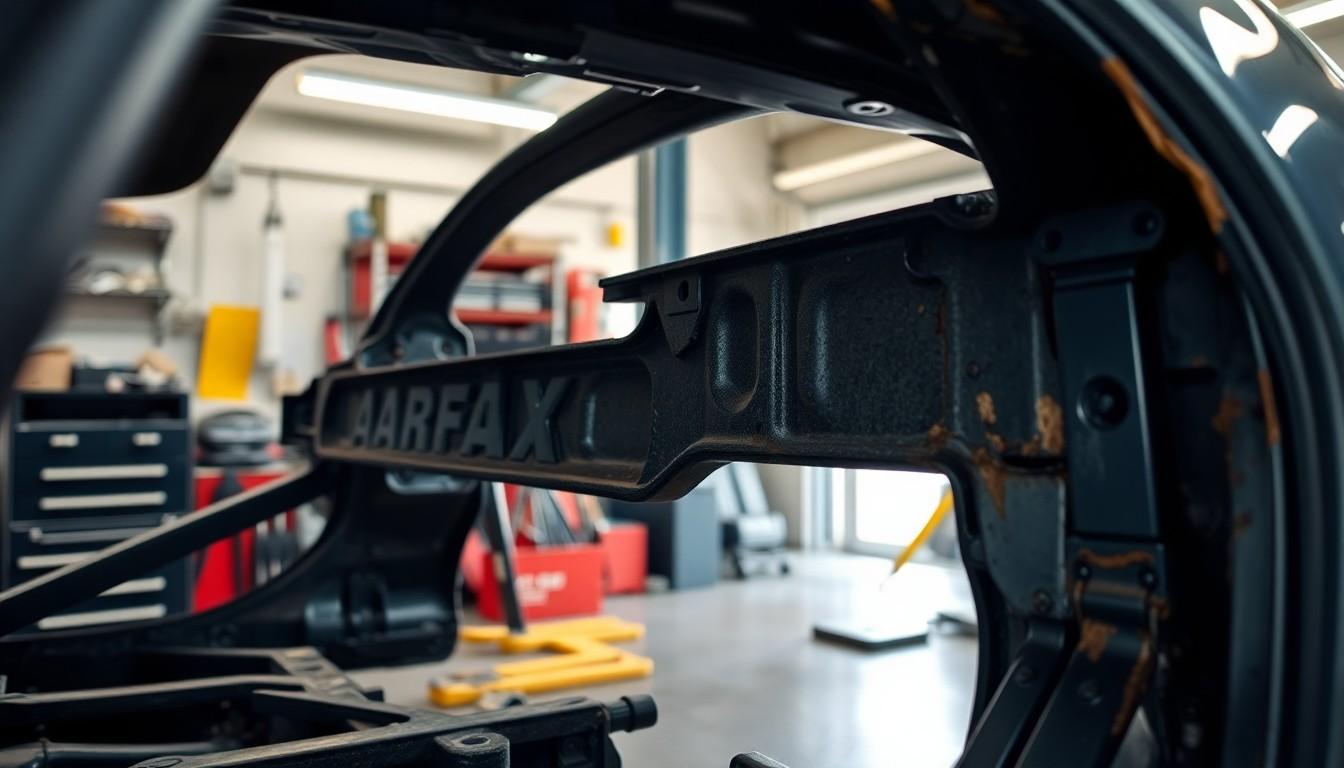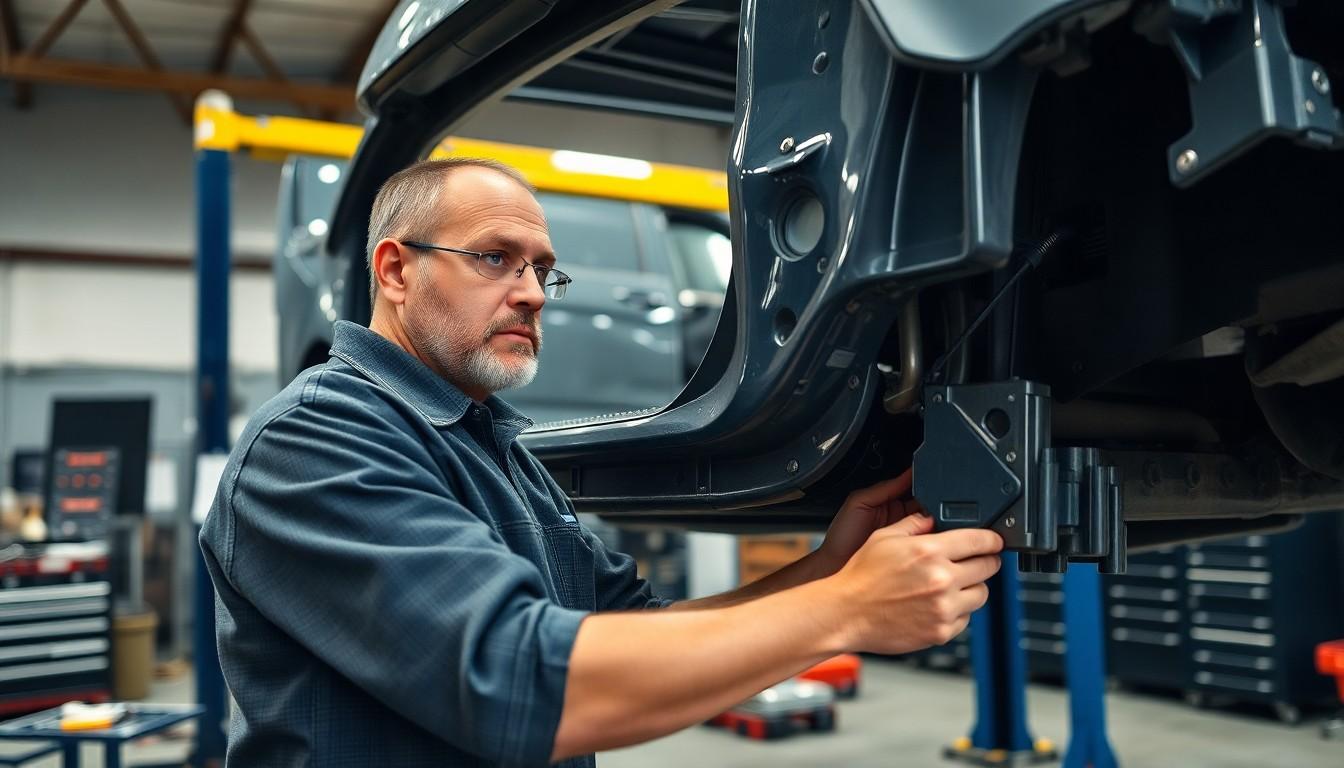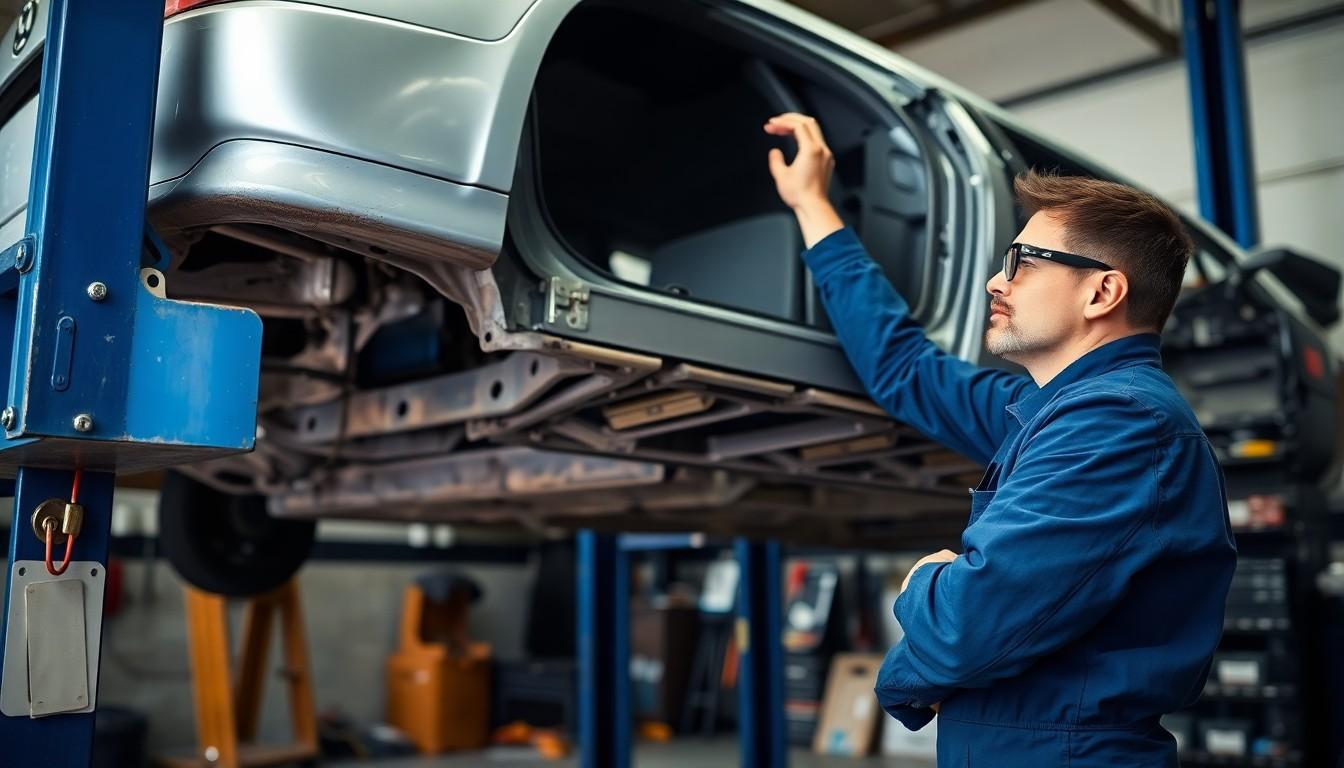When shopping for a used car, seeing “structural damage” on a Carfax report can stop us in our tracks. This frightening term often conjures images of unsafe vehicles and expensive repairs, but what does it really mean for your potential purchase?
We’ve helped thousands of car buyers navigate the sometimes confusing industry of vehicle history reports. Structural damage on Carfax indicates that a vital component of the vehicle’s frame or unibody has been compromised at some point. This could range from minor incidents that were properly repaired to serious accidents that might affect the car’s safety and value.
Understanding Structural Damage on Carfax Reports
Structural damage on a Carfax report indicates that a vehicle’s frame or unibody has sustained damage at some point in its history. Carfax collects this information from various sources including insurance companies, repair facilities, and auto auctions. Their reports typically flag structural damage when repairs have been documented through an insurance claim or when a professional inspection identifies frame damage.
Different severity levels exist for structural damage, ranging from minor frame bends that can be properly repaired to major accidents that compromise the vehicle’s integrity. Carfax doesn’t generally distinguish between these severity levels in their reporting, often simply marking a vehicle with a “structural damage” notification without providing extensive details about the extent of the damage.
Insurance companies frequently report structural damage to Carfax after accidents where a vehicle’s frame requires repair. Auto body shops and collision repair centers also contribute to these reports when they perform frame straightening or welding. Auction houses sometimes note structural issues during their pre-sale inspections, adding another data point to a vehicle’s history.
It’s important to recognize that a structural damage notation doesn’t automatically mean the vehicle is unsafe to drive. Many vehicles with properly repaired structural damage function safely for years afterward. The key factor is the quality of repairs performed and whether they were completed according to manufacturer specifications by qualified technicians.
Types of Structural Damage Flagged on Carfax

Structural damage on a Carfax report encompasses several categories that affect a vehicle’s framework integrity. These damage types can range from minor incidents to severe accidents that significantly impact a vehicle’s safety and performance.
Frame and Unibody Damage
Frame damage occurs when the vehicle’s structural skeleton sustains impact, often from severe collisions. Even minor frame damage can compromise the vehicle’s structural integrity, affecting alignment, safety systems, and overall performance. Modern vehicles typically use unibody construction, where the frame and body form a single unit, making any damage particularly concerning.
Unibody damage includes any compromise to this integrated structure. Carfax reports often flag unibody damage regardless of severity – even dents less than 1 inch can be classified as structural damage. This classification stems from how these seemingly minor issues can affect the vehicle’s crash absorption capabilities and overall structural performance.
Bent axles represent another common frame issue detected following accidents. These problems typically manifest as handling difficulties, with the vehicle pulling to one side or exhibiting unusual tire wear patterns. Damaged crumple zones also fall under this category, affecting the car’s ability to absorb impact energy in future collisions.
Flood and Fire Damage
Flood damage appears separately on Carfax reports yet deserves careful consideration when evaluating a vehicle’s history. Water submersion can cause extensive damage to electrical components, mechanical systems, and interior materials. This damage often manifests gradually over time as corrosion progresses through vital systems.
Fire damage similarly receives distinct classification on Carfax reports. Vehicles exposed to fire can suffer from compromised electrical systems, weakened metal components, and damaged safety features. The extent of fire damage varies significantly depending on the fire’s intensity and duration, with even minor incidents potentially causing hidden structural weaknesses.
Both flood and fire damage create complex problems that extend beyond immediate visible issues. While not categorized directly as structural damage on Carfax, these conditions frequently lead to structural integrity concerns as materials weaken or deteriorate from their exposure to extreme conditions.
How Structural Damage Appears on a Carfax Report

Structural damage notations on Carfax reports frequently result from impacts to critical vehicle components that affect overall integrity. These reports highlight repairs or damage to structural elements regardless of severity, potentially flagging even minor incidents.
Decoding the Terminology
Carfax reports often use exact terminology that requires careful interpretation. The phrase “structural damage” typically indicates that repair work has been performed on crucial frame components, not necessarily that the vehicle currently has unresolved structural issues. Auction announcements frequently employ broad terms like “Airbag/Unibody/Frame/Structural” based on NAAA Auction Arbitration Rules, giving little distinction between minor incidents and major accidents. These standardized terms appear when a vehicle inspection at auction reveals any repair or replacement of welded-on structural components, creating a permanent record in the vehicle’s history regardless of repair quality.
Severity Classifications
Carfax doesn’t differentiate between minor and major structural damage in its reporting system. Location takes precedence over severity when classifying structural issues—damage to trunk floors, rocker panels, or inner wheel housings all qualify as structural regardless of extent. Even minor dents ranging from 1/8 inch to 1 inch on critical components can trigger a structural damage notation on a Carfax report. The reporting method creates no distinction between a small parking barrier tap and a important collision, as both can affect the same structural components. This classification approach means buyers must investigate beyond the simple “structural damage” label to understand the true condition of the vehicle.
Impact of Structural Damage on Vehicle Value

Structural damage documented on a CARFAX report significantly affects a vehicle’s financial worth in both immediate and long-term contexts. This type of damage creates a permanent record that follows the vehicle throughout its lifetime, influencing buyer perception and market value.
Immediate Depreciation Effects
Vehicles with structural damage notations typically experience a 20-30% drop in value compared to similar undamaged vehicles. For instance, a car normally valued at $20,000 might only command $15,000 with structural damage on its history report. This immediate depreciation stems from the perceived risk and potential future problems associated with compromised structural integrity. Dealers and private buyers alike factor this history into their purchase decisions, often using it as leverage to negotiate substantial price reductions.
Long-Term Resale Implications
The resale value of vehicles with structural damage remains persistently lower even years after repairs. Even though professional restoration, the CARFAX record continues to show the damage history, creating a lasting stigma that’s difficult to overcome. Market perception plays a crucial role in this devaluation, as potential buyers generally view these vehicles as higher-risk investments compared to cars with clean histories.
Financial considerations extend beyond the initial purchase savings. While buying a structurally damaged vehicle offers upfront cost advantages, owners typically face challenges when selling. These vehicles often remain on the market longer and eventually sell for less than their undamaged counterparts. The compounding effect of slower sales and lower prices creates a important disadvantage for owners looking to recoup their investment or trade up to another vehicle.
How Structural Damage Is Reported to Carfax

Carfax receives structural damage information from multiple sources that document vehicle incidents and repairs. These reports create a comprehensive history that potential buyers use to evaluate a vehicle’s condition and value.
Insurance Company Reports
Insurance companies serve as primary sources for structural damage information in Carfax reports. After accidents, insurers conduct detailed assessments to determine repair costs and document any structural compromise. These companies don’t distinguish between minor and major structural issues when reporting to Carfax, classifying even small dents (1/8 inch to 1 inch) as structural damage due to modern unibody construction techniques. Insurance claims involving frame repairs automatically trigger structural damage notations in the vehicle’s history, regardless of the repair quality or the damage severity. Auction announcements often include terms like “Airbag/Unibody/Frame/Structural” based on NAAA Auction Arbitration Rules, indicating the vehicle has experienced structural damage at some point in its history.
Repair Shop Documentation
Auto repair facilities contribute important data to Carfax’s structural damage reports through their detailed repair records. When technicians work on a vehicle’s chassis or underlying structure, they document all repairs performed, creating a record that eventually appears on Carfax. These shop reports include information about frame straightening, unibody repairs, or replacement of structural components that maintain the vehicle’s integrity. Repair shops typically note the exact components affected, repair methods used, and whether manufacturer specifications were followed during restoration. This documentation helps establish the extent of the original damage and the thoroughness of repairs, though the Carfax report itself won’t differentiate between professional repairs and substandard work. The accuracy of these reports directly impacts how potential buyers perceive the vehicle’s condition and influences its market value, often reducing it by 20-30% compared to vehicles with clean histories.
Buying a Car With Structural Damage History

Purchasing a vehicle with structural damage history requires careful consideration of both risks and potential savings. Cars with structural damage records on Carfax typically sell for 20-30% less than comparable vehicles with clean histories, offering important financial advantages for buyers willing to accept the associated risks.
Inspection Recommendations
Professional mechanical evaluations are essential when considering a car with structural damage history. Qualified mechanics can assess the extent of previous damage and identify any lingering issues that might affect safety or performance. These inspections should focus on alignment problems, as structural damage often compromises a vehicle’s ability to track straight and maintain proper wheel positioning.
Request comprehensive repair documentation to understand what components were affected and how thoroughly repairs were completed. Mechanics should examine critical areas including frame rails, crumple zones, and unibody components for signs of proper restoration. Pay particular attention to welding quality, replacement part compatibility, and overall structural integrity during this assessment process.
Negotiation Strategies
Leverage the structural damage history as a key negotiating point when discussing price with sellers. The Carfax report provides concrete evidence of the vehicle’s compromised history, justifying your request for a substantial discount from comparable clean-history vehicles. Calculate potential future repair costs related to the structural issues and factor these expenses into your offer.
Discuss warranty implications directly with sellers, as structural damage may void manufacturer warranties or limit coverage for related components. Get any seller assurances about the vehicle’s condition in writing as part of your purchase agreement. Request written disclosure of all known structural damage and subsequent repairs to protect yourself legally if problems emerge later.
Consider resale implications during negotiations, as the structural damage notation will remain on the vehicle’s history permanently, affecting its future marketability. Smart buyers balance the initial savings against potential long-term costs and reduced resale value when determining a fair purchase price for vehicles with documented structural damage.
Can Structural Damage Reports Be Removed or Corrected?

Structural damage reports on CARFAX typically remain as permanent parts of a vehicle’s history. Once this information enters the CARFAX database through auction announcements or repair records, it becomes a lasting element of the vehicle’s documented past. CARFAX regularly updates its records based on information from repair shops, auctions, and other vehicle history reporting services, but removal of structural damage notations rarely occurs.
Corrections to CARFAX reports are possible in limited circumstances. When vehicles undergo complete structural repairs, the terminology might shift from “structural damage” to “structural repair” on the report. This change acknowledges that remediation has occurred while maintaining transparency about the vehicle’s history. The fundamental record of damage, but, remains accessible to potential buyers regardless of repair quality.
Vehicles with structural damage notations face important market value reductions. These cars typically sell for considerably less than identical models with clean CARFAX reports, often experiencing a price reduction that makes them more affordable for budget-conscious buyers. This lower valuation persists throughout the vehicle’s lifetime, affecting its resale potential even years after proper repairs have been completed.
No standardized process exists for removing legitimate structural damage reports from CARFAX. This policy reflects CARFAX’s commitment to providing comprehensive vehicle histories that help buyers make informed decisions. The permanent nature of these records underscores the importance of avoiding structural damage and maintaining proper documentation of any high-quality repairs completed.
Conclusion
Structural damage on a Carfax report doesn’t automatically mean a vehicle should be avoided. It requires careful interpretation and professional assessment. While these vehicles typically sell for 20-30% less than their undamaged counterparts the savings must be weighed against potential issues and future resale challenges.
Remember that Carfax reports don’t distinguish between minor and major structural damage nor do they evaluate repair quality. A professional inspection is essential before purchasing any vehicle with structural damage history.
By understanding what structural damage really means on Carfax you’ll be better equipped to make informed decisions when shopping for used cars. This knowledge can help you negotiate effectively and potentially find a reliable vehicle at a important discount.
Frequently Asked Questions
What does “structural damage” on a Carfax report mean?
Structural damage refers to damage affecting a vehicle’s frame or unibody – the skeleton that holds everything together. This can range from minor dents in frame rails to major damage from serious accidents. Unlike cosmetic damage, structural issues can affect a car’s safety, alignment, and overall integrity.
How does structural damage affect a car’s value?
Vehicles with structural damage typically experience a 20-30% reduction in value compared to similar undamaged vehicles. This depreciation persists even after professional repairs because the damage remains on the Carfax report. These vehicles also tend to stay on the market longer and sell for less than their undamaged counterparts.
Can a car with structural damage be safe to drive?
Yes, a properly repaired car with structural damage can be safe to drive. The key factors are repair quality and adherence to manufacturer specifications. Many vehicles with structural damage operate safely for years following professional repairs. However, a mechanical inspection is recommended to verify the repairs were completed correctly.
How is structural damage reported to Carfax?
Structural damage is reported primarily by insurance companies and repair facilities. Insurance companies document damage during accident claims, while repair shops record chassis work performed. Modern unibody construction means even small dents in critical areas can be classified as structural damage in reports.
Does Carfax distinguish between minor and major structural damage?
No, Carfax doesn’t differentiate between severity levels of structural damage. The system simply flags that structural damage occurred without providing extensive details about its severity. Location of damage takes precedence over severity in Carfax’s classification system, making further investigation necessary for potential buyers.
Can a structural damage report be removed from Carfax?
Generally, structural damage reports remain permanently on Carfax records. Corrections are possible in limited circumstances, such as data entry errors or when complete structural repairs have been certified. However, the fundamental record of damage typically remains accessible to potential buyers throughout the vehicle’s lifetime.
Should I buy a car with structural damage on its Carfax report?
This depends on your priorities. Vehicles with structural damage histories typically sell for 20-30% less than comparable cars with clean histories, offering potential savings. However, you should always get a professional mechanical evaluation, use the damage history as a negotiation point, and consider potential impacts on warranties and future resale value.
What types of structural damage are commonly reported on Carfax?
Common types include frame and unibody damage affecting the vehicle’s skeleton, bent axles that impact alignment and handling, and damaged crumple zones that compromise safety systems. While not classified as structural damage, flood and fire damage can also lead to integrity concerns due to corrosion and weakened materials over time.

